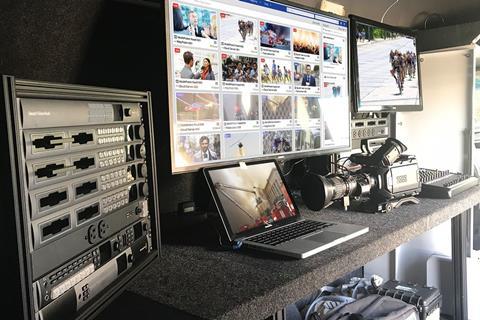Increasing audience demands for more content and more engagement are driving a new wave of remote production, but the big players stress that, as ever, connectivity is a key factor.
The idea of remote production has long seemed attractive. Production facilities, whether they are fixed or in a truck, are expensive capital investments, and having them non-productive while they move from one venue to another is not good business.

Along with the cost of moving the hardware, there is the cost of moving the people: travel, accommodation and subsistence. Those people are likely to be less productive in a truck or a temporary installation on location than they are in the familiar surroundings of their home base where they can set everything up just right and know where to get the best coffee.
Obviously cameras and their operators still need to be moved to the location, but the potential for savings, and quality improvements, seem real.
Indeed, broadcasters have been sampling it for perhaps 20 years. Early pioneers were in Scandinavia, where severe winters mean moving expensive trucks around was a challenge.
Practical, large-scale implementations have been more recent.
Nevion Vice-President of Marketing Olivier Suard says: “Nevion started doing proper remote production in the last five to 10 years when fibre made it possible to carry video, audio, comms and data bi-directionally in real time in a cost-effective manner.”
Nevion worked on a pioneering project with the western USA college sports alliance Pac-12 Conference, a finalist in the IBC2015 Innovation Awards. This is a clear demonstration of pure remote production: the cameras go to the events at 12 universities in California and Nevada, but the directors sit in one of three control rooms in San Francisco. The result is huge cost savings.
Today the view on remote production is not just about pure cost-efficiency, though. It is increasingly about the audience’s expectation of more content and more engagement.

Grass Valley Vice-President of Live Production Mark Hilton says: “To attract and retain viewers, TV providers are required to deliver increasing amounts of content and ensure the most immersive fan experience for viewers. This means delivering more camera angles and making content available whenever and wherever, via a wide range of platforms.”
Nevion’s Suard, talking about the remote production solution in place for BT and the English Premier League, adds that when transporting between 20 and 40 uncompressed camera feeds from each stadium, “it enables feeds to be used to provide coverage that is relevant to particular markets, such as following a player from a specific country.”
Dejero Director of Product Management Yvonne Monterroso, says: “The amount of live content surrounding the event is continuing to grow. Whether it is a live stream from a fanzone, reports from the team base camps or athletes’ village, or post-event interviews, reporters and production teams are continually finding creative ways to provide top quality content to audiences.”
Aperi CEO Joop Janssen adds: “These issues are now relevant, because we have the technology to achieve real remote production. More robust, native-IP technology came to the forefront.

“Solutions didn’t just connect two boxes via IP, but really allowed for new ways of working,” he adds. “People are now looking beyond IP simply as a connection tool and are trusting in what it enables.”
“SMPTE 2110 brings other benefits such as reliable, fast SDI-level performance, full operational transparency in IP environments, and independent audio and video routing,” adds Grass Valley’s Hilton. “As home studios consolidate their remote production operations, the use of virtualised cloud technologies is expected to generate further cost savings.”
While the use of IP to bring feeds back from remote locations is well proven, true remote production – bringing all the sources back for switching and balancing – adds another significant technical challenge: latency – “often considered the biggest challenge,” according to Hilton. The director in the control room back at base needs to be able to communicate with the crew on the ground.
There is inevitably a trade-off between the bandwidth demands of uncompressed signals and the latency of encoding and decoding. “For HD, the preferred codecs remain JPEG2000 and H.264,” says Nevion’s Suard. “For 4K Ultra HD we are beginning to see the emergence of Tico, although JPEG2000 is also a viable option.
“Because of the need for realtime two-way communication, higher but slower compression codecs like H.265 are less attractive,” he adds.
On-demand webinar Why remote production is a game changer for sport
Future roadmap
Aperi has an extensive, proven remote production installation in Australia with network provider Telstra, and Joop Janssen sees it as a sign of things to come, not least for events this summer like the FIFA World Cup: “Adopting software-centric media processing brings about fairly substantial resource and cost savings, while increasing creativity, quality and the overall output.”
He does, however, go on to point out that there are new considerations in system design, not least redundancy and security.
NEP Group Senior Vice-President of Technology and Asset Management Scott Rothenberg says: “Security is becoming an increasing concern. Among the approaches we take is to keep video streams off the same switches as ‘public internet’ traffic.
“In addition, we choose our connectivity partners very carefully, and they have various methods to keep the networks secure,” he adds. “Finally, we don’t comment on specific security policies or protocols publicly.”
Mark Hilton of Grass Valley agrees that the connectivity service provider has the leading role to play in securing the content: “WAN connections can be encrypted to enhance security, and IT industry technologies can be leveraged to handle most, if not all, of the challenges that will emerge in remote production.”

Nevion’s Suard adds: “WAN transport typically takes place over highly secure, dedicated links provided by reputable telecom service providers.
“The transport within facilities – the LAN – is also thought of as secure,” he says. “Where the greatest concern lies is at the interface between the WAN and the LAN. That is why particular care needs to be taken at what is referred to as the IP media edge.”
A word of caution comes from Scott Rothenberg of NEP: “It is important to keep in mind, though, that IP may not be applicable in all geographies, and that the same approach might not be the right approach in all situations.”
Clearly, remote production is ready to go, but while it opens up new opportunities and transformed workflows, it is also a new set of technologies that need to be understood.

Rothenberg sums it up with “plan ahead, understand the scope and what needs to be accomplished, recognise that training the crew is critical – and choose a trusted partner like NEP.”
Last word goes to Yvonne Monterroso of Dejero: “By centralising the production, crews in the field need less equipment and can focus on capturing the live feed. It really comes down to the ability to do more live content, and to do it more cost-effectively.”
Read more “IP future not too far away”, says BBC
























No comments yet